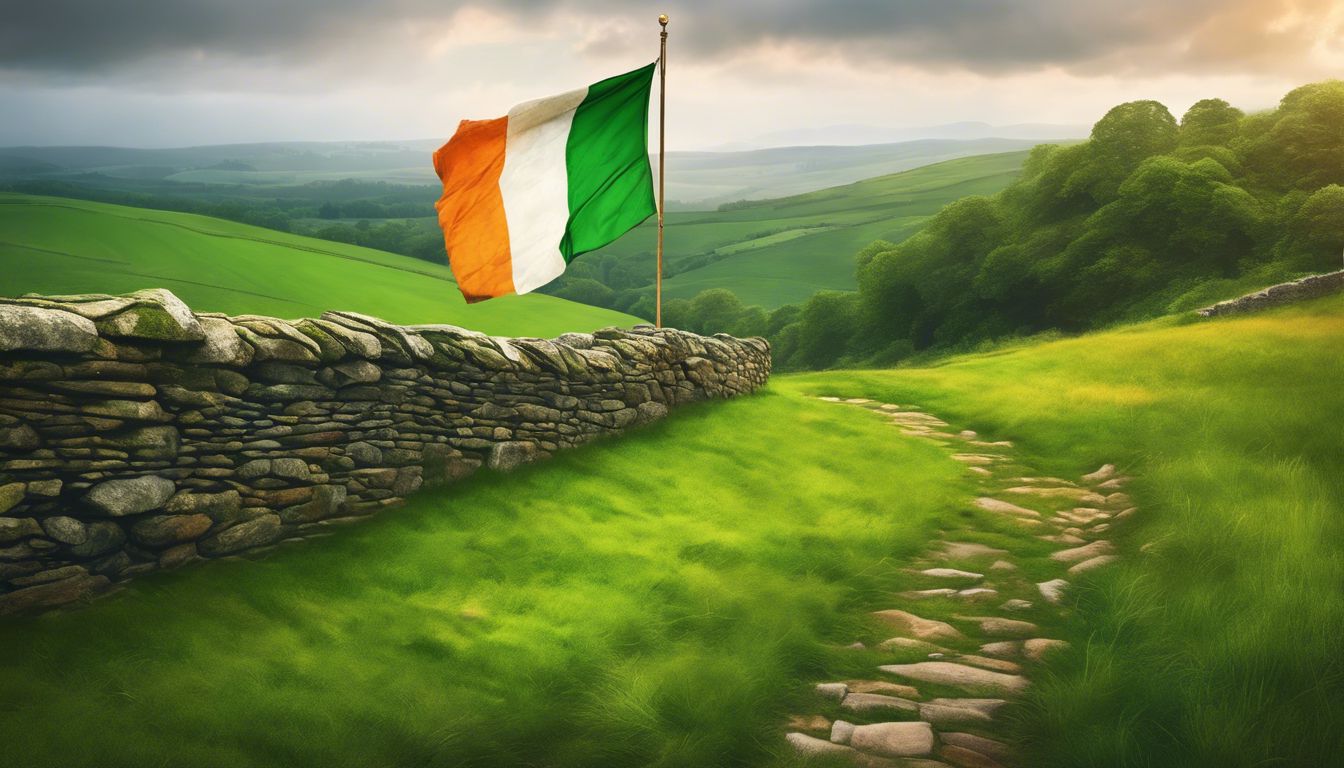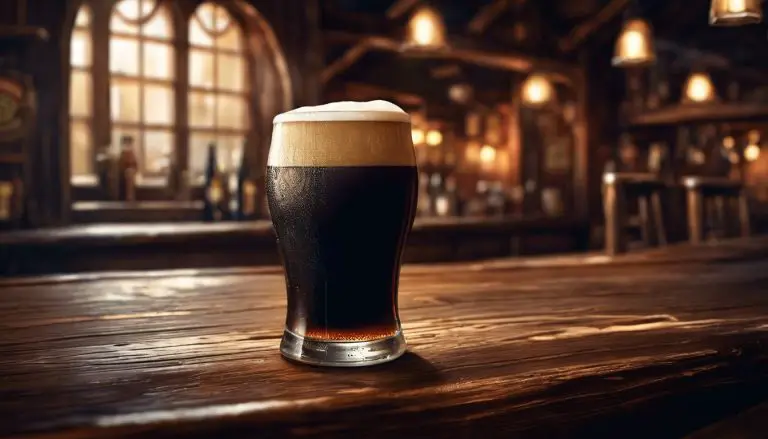What Is the Irish Flag: History, Symbolism, and Meaning
The Irish flag is a special symbol with three colors: green, white, and orange. Each color has its own meaning. Long ago, different flags waved over Ireland. But the tricolour flag that we see today started in the 19th century.
Green represents the Irish people who wanted their own country and followed Catholic traditions. Orange stands for Protestants who looked up to William of Orange.
White in the middle is a sign of hope for peace between these two groups. The flag tells a story of how Ireland fought to be free from British rule. It’s not just a piece of cloth; it means that everyone in Ireland should feel included no matter what they believe or where they come from.
Even today, this flag shows up on holidays and in Irish pubs across the world as a proud reminder of Irish identity and history. This flag isn’t just about colors; it tells us about coming together and trying to understand each other better in Ireland’s rich culture.
Let’s learn more about this powerful symbol!
Key Takeaways
- The Irish flag has three vertical stripes: green for Irish nationalism and Catholics, white for peace, and orange for the Protestant minority.
- Created in 1848 during the Young Irelander Rebellion, the tricolour symbolizes a desire for unity between different religious and cultural groups in Ireland.
- The flag’s design comes from earlier flags like Saint Patrick’s Saltire and the Green Harp Flag, showing Ireland’s evolving identity over time.
- In Northern Ireland, feelings about the flag are complex because it represents both Irish nationalism and Protestant heritage.
- The Irish flag is proudly displayed on holidays such as St. Patrick’s Day and at events to honor national pride. Proper handling of the flag shows respect for its significance.
History of the Irish Flag
The history of the Irish flag dates back to previous flags used in Ireland before the creation of the tricolour flag, which is now a symbol of national unity and identity. The design and symbolism behind the colors of green, white, and orange reflect significant religious and political representations in Irish history.
Previous flags used in Ireland
Ireland has had many flags throughout its history. Each one tells a part of the Irish story.
- Saint Patrick’s Saltire: A red X on a white field, used to represent Ireland in the Union Jack.
- Green harp flag: From the 15th century, a gold harp on a green background symbolized the island.
- Blue ensign with harp: In the 18th century, this flag often flew on ships and was associated with royalty.
- Erin go Bragh flag: Translating as “Ireland Forever,” it carried a green field with harp and shamrocks.
- Sunburst flag: An old emblem featuring a golden sun on a green background represented rebirth and resurrection.
The creation of the tricolour flag
The tricolour Irish flag, made up of green, white, and orange vertical stripes, holds deep historical significance. It was created in 1848 during the Young Irelander Rebellion. The green stripe represents Irish nationalism and Catholics, the orange signifies the Protestant minority and supporters of William of Orange, while the white symbolizes unity and peace between these two groups.
This visually striking flag has since become a powerful representation of Irish heritage and identity not just within Ireland but also around the world.
Design and Symbolism of the Irish Flag
The Irish flag consists of vertical stripes of green, white, and orange, with each color holding symbolic meaning. Green represents Roman Catholicism, orange symbolizes the Protestant minority, and the white stripe stands for peace between the two communities.
Vertical stripes of green, white, and orange
The tricolour of the Irish flag consists of vertical stripes in green, white, and orange. The use of these specific colors holds deep symbolic meaning for Ireland and its history. Green symbolizes Irish nationalism, while orange represents Ireland’s Protestant minority.
The white stripe between them signifies the hope for lasting peace and unity among these groups. These colors reflect the country’s complex history and ongoing pursuit of reconciliation between different religious and cultural factions in a unifying national symbol.
Moving on to “Design and Symbolism of the Irish Flag,” let’s explore how these elements contribute to its significance and representation in Irish culture.
Representations of Catholicism, Protestantism, and peace
The green on the Irish flag symbolizes Irish nationalism, particularly the Roman Catholic community in Ireland. The orange represents Ireland’s Protestant minority and their connection to William of Orange.
Meanwhile, the white signifies the hope for lasting peace and unity between these two groups. This tricolour is a powerful representation of Ireland’s complex history, as well as its ongoing journey towards peace and reconciliation among different religious and cultural factions.
In summary, the Irish flag with its green, white, and orange colors reflects the country’s rich heritage, complexities surrounding Catholicism and Protestantism, while embodying an enduring message of hope for peace and unity among all its people.
Use of the flag in Northern Ireland
The Irish flag holds significant meaning in Northern Ireland, where it can be a symbol of identity and political allegiance. However, due to its association with the Republic of Ireland and Irish nationalism, some people in Northern Ireland may not embrace it as their own.
The orange color on the flag has been associated with the Protestant Orange Order, leading to complex feelings about the tricolour flag among certain communities in Northern Ireland.
The use of the Irish flag in Northern Ireland reflects historical and cultural complexities, often serving as a point of contention rather than unification. As a result, its display is sometimes approached with sensitivity and caution in this region marked by deep-rooted divisions.
Current Use and Protocol of the Irish Flag
Displaying the Irish flag on certain holidays and occasions is a common practice in Ireland. It’s important to know the proper handling and care of the flag to show respect for its significance.
Displaying the flag on certain holidays and occasions
The Irish flag is displayed on specific holidays and occasions.
- St. Patrick’s Day: The Irish flag is prominently displayed during the celebrations of Ireland’s patron saint, St. Patrick’s Day, as a symbol of national pride and heritage.
- Easter Rising Commemoration: It is hoisted during the commemoration of the Easter Rising, a significant event in Irish history, to honor those who fought for independence.
- Independence Day: On Ireland’s Independence Day, the flag takes center stage, reminding citizens of the hard-won sovereignty and struggle for freedom.
- State Visits: During official state visits or receptions by foreign leaders, the flag is flown to represent the nation and extend a warm welcome.
- National Sports Events: At major sporting events such as Gaelic games, rugby matches, and soccer fixtures, the flag is proudly raised to support Irish athletes and teams.
- Cultural Festivals: The tricolour adorns cultural festivals that celebrate Irish music, dance, literature, and arts as an emblem of national identity and tradition.
- Memorial Services: During solemn occasions like memorial services for fallen heroes or important figures in Irish history, the flag serves as a mark of respect and remembrance.
Proper handling and care of the flag
When displaying the flag on certain holidays and occasions, it is essential to handle and care for the Irish flag with respect and diligence. Here are some important guidelines:
- Always hoist the flag briskly and lower it ceremoniously.
- Avoid displaying a damaged or faded flag – it should be in good condition.
- The flag should never touch the ground or be soiled.
- It is respectful to not fly the flag after sunset unless properly illuminated.
- During strong weather conditions, ensure the flag is secure and protected from damage.
Significance and Meaning of the Irish Flag
The Irish Flag is a unifying symbol of Ireland, representing Irish nationalism and heritage. Its cultural significance has led to widespread recognition around the world, often seen in Irish pubs and on merchandise.
Unifying symbol of Ireland
The Irish flag, with its vibrant green, white, and orange tricolour, serves as a unifying symbol for the people of Ireland. Its design holds deep historical significance and represents the nation’s aspiration for peace and unity.
The green embodies Irish nationalism, while the orange represents the Protestant minority, and the white signifies hope for lasting peace between these diverse groups. This iconic flag has been a powerful representation of Irish identity and heritage globally, fostering a sense of common purpose and connection among all those who proudly call Ireland home.
Representing more than just colors on fabric, this tricolour is steeped in history — it emerges from a struggle for independence yet remains an influential emblem that unites people both within Ireland and around the world.
Representation of Irish nationalism and heritage
The Irish flag, with its vertical stripes of green, white, and orange, represents the rich heritage and nationalism of Ireland. The green symbolizes Irish nationalism, while the orange represents Ireland’s Protestant minority.
In addition to this, the white signifies the hope for peace and unity between different religious and cultural groups in Ireland. The flag has been a unifying symbol for centuries and continues to be deeply rooted in Irish history as an emblem of national pride and identity.
The tricolour flag has evolved into a potent representation of Irish culture around the world. Its design reflects a significant period in Irish history when it became associated with the struggle for independence.
Cultural significance and recognition around the world
The Irish flag holds significant cultural symbolism worldwide, identifying with the global Irish diaspora and standing as a proud emblem of Ireland’s enduring spirit. Its recognition extends to various international events, where it symbolizes the nation’s rich heritage and commitment to peace.
The flag is also prominently displayed during St. Patrick’s Day celebrations across the globe as a unifying symbol that resonates with people of all backgrounds, fostering a sense of shared identity and inclusivity.
Moreover, the tricolour design has become an integral part of Irish cultural representation in merchandise and popular culture globally, adorning products such as clothing, accessories, and decor in tribute to Ireland’s profound historical legacy.
Common use in Irish pubs and merchandise
Irish pubs often proudly display the tricolour flag as a symbol of national pride and solidarity. The flag is commonly featured in Irish merchandise, from clothing to souvenirs, serving as a powerful emblem of Irish heritage for locals and tourists alike.
Its vibrant colors and rich historical significance make it a popular decorative element that embodies the spirit of Ireland’s cultural identity.
As we explore further nuances of this iconic flag, let’s delve into its current use and protocol within Ireland.
Conclusion
In conclusion, the Irish flag’s tricolour design embodies deep historical symbolism. The green, white, and orange stripes represent Catholicism, peace, and Protestantism. Displayed with pride on special occasions, the flag unites Ireland’s diverse cultural heritage.
Its enduring significance reflects a hope for lasting unity and understanding among its people. This iconic symbol continues to resonate both within Ireland and across the globe.
FAQs
1. What does the Irish flag look like?
The Irish flag has three equal stripes: green, white, and orange. Green represents Irish symbolism and Roman Catholicism, orange stands for Protestant minority and Orange Order symbolism, and white symbolizes peace between them.
2. Why are there green and orange colors on the Irish flag?
Green on the Irish flag is a nod to Ireland’s history and serves as a symbol for Roman Catholics. The orange stripe represents Protestants in Ireland and honors the Orange Order.
3. What does the white part of the Irish Flag mean?
The white stripe in the middle of the Irish flag means peace. It shows hope for unity between Catholics represented by green and Protestants indicated by orange.
4. When did they first use the current design of Ireland’s flag?
They first used Ireland’s current green, white, and orange striped flag in 1848 during efforts to gain independence from Britain. This design brings together symbols of both major communities in Ireland.







